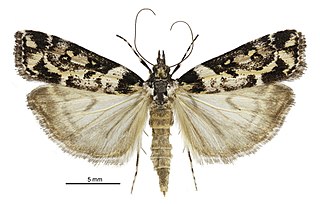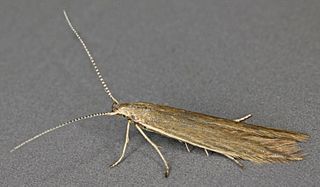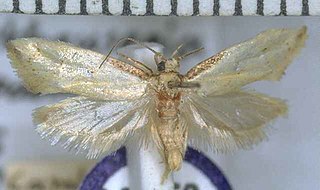
Hellinsia tephradactyla is a moth of the family Pterophoridae found in most of Europe. It was first described by the German taxonomist Jacob Hübner in 1813.
Xyroptila peltastes is a moth of the family Pterophoridae. It is found in Australia.

Hexadactilia trilobata is a moth of the family Pterophoridae described by Thomas Bainbrigge Fletcher in 1910. It is found in Australia in Queensland and New Guinea.

Deuterocopus atrapex is a moth of the family Pterophoridae described by Thomas Bainbrigge Fletcher in 1909. It has been recorded from Sri Lanka, Assam, Selangor, the Tenasserim Hills, south-eastern Borneo, Ternate, Ambon Island, Batian, southern Sulawesi, the Sangihe Islands, Halmahera, Neu Pommern, northern New Guinea, the Kei Islands, the D'Entrecasteaux Islands and Queensland.

Deuterocopus tengstroemi is a moth of the family Pterophoridae. It is known from Java and Queensland, Australia.

Sphenarches zanclistes is a moth of the family Pterophoridae that is found in Australia.

Ypsolopha nemorella is a moth of the family Ypsolophidae. It is found in northern and central Europe, mid-eastern China and Russia.

Eudonia diphtheralis is a species of moth in the family Crambidae. It is endemic to New Zealand.

Coleophora alticolella is a moth of the family Coleophoridae, found in Europe and North America.
Adaina cinerascens is a moth of the family Pterophoridae. It is found in North America
Oidaematophorus cretidactylus is a moth of the family Pterophoridae that is found in North America.

Hellinsia tinctus is a moth of the family Pterophoridae. It is found in Arizona and Mexico.
Eupoecilia cracens is a species of moth of the family Tortricidae first described by Alexey Diakonoff in 1982. It is found in Sri Lanka.
Athrips profusa is a moth of the family Gelechiidae first described by Edward Meyrick in 1921. It is found in Zimbabwe.
Antaeotricha trichonota is a species of moth of the family Depressariidae. It is found in Brazil and Paraguay.
Stenoma recondita is a species of moth of the family Depressariidae. It is found in Guyana.
Psittacastis championella is a moth in the family Depressariidae. It was described by Lord Walsingham in 1912. It is found in Guatemala.
Psittacastis stigmaphylli is a moth in the family Depressariidae. It was described by Lord Walsingham in 1912. It is found on Jamaica.

Tingena anaema is a species of moth in the family Oecophoridae. It is endemic to New Zealand and has been collected at Lake Wakatipu, Invercargill and Stewart Island / Rakiura. The adults of the species are on the wing in December.

Tingena apanthes is a species of moth in the family Oecophoridae. It is endemic to New Zealand and found on the North Island. The adults are on the wing from October to December. It appears associated with Leptospermum species and it has been hypothesised that the appearance of the adults of this species imitates faded Leptospermum leaves.










